Executive Summary
- √Some NFT prices – and their tokens – have dropped -70% from the recent highs. The value proposition that NFTs offer still remains, in our view, and therefore the current price level might offer an opportunity to gain exposure
- √While there are many different use cases for NFTs, similar to other parts of the (blockchain) technology stack, NFTs are evolving rapidly with the next round of innovation focusing on ‘dynamic NFTs’, this part of the digital asset space keeps evolving
- √Investors can consider scarcity, utility, liquidity and community characteristics in estimating the value potential of NFTs
- √The NFT market is anticipated to have the potential to grow at a compound annual growth rate of +33.9% until 2030 where it could reach up to 211.72 billion USD in market size
- √The opportunity for larger and regular cash flows would encourage more artists into the NFT space which would contribute to driving further growth of the NFT market.
Exhibit 1: BAYC Floor Price in USD
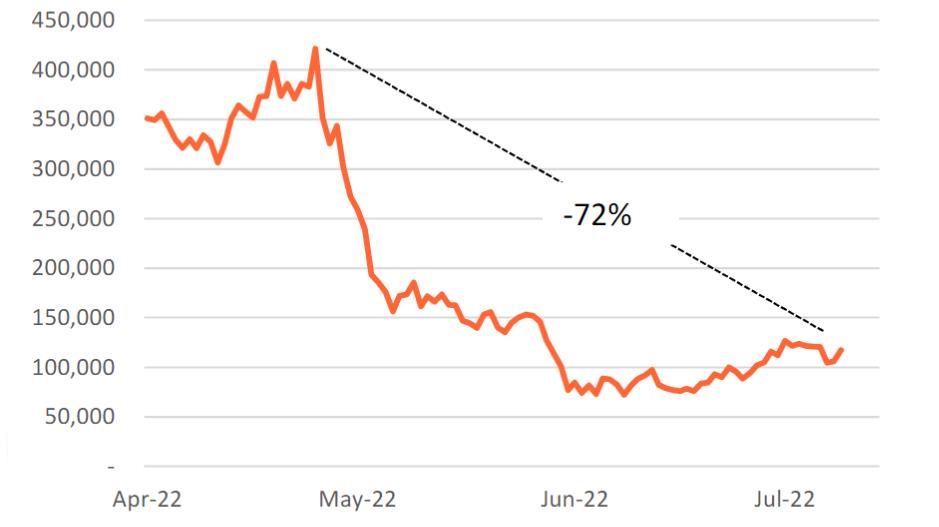
Source: Coingecko, IDEG Research, July 28, 2022
How are NFTs valued?
At first glance, NFTs do not appear to be worth much – The BAYC and CryptoPunk NFTs that sell for over $200,000 at the end of the day are just links to a jpeg file that anyone can download from the internet with a quick google search.
The lack of exclusivity of access to these images would normally be a drastically devaluating factor, however the real value added of NFTs comes from the blockchain it lives on – every transaction between buyers and sellers is recorded on the immutable digital ledger, giving buyers verification of an asset’s authenticity.
Buyers can claim ownership and rights over their original, unique NFT - previous ownership, price history information are all recorded on the blockchain, stopping the creation of false digital assets in its tracks.
NFTs are difficult to value due to their subjective worth to buyers – similar to how it is difficult to value artwork. As a result, the value of NFTs tends to be more speculative and volatile – for example, Jack Dorsey’s first tweet ever that sold for $2.9 million USD was put up for auction at an initial asking price of $48 million, only to receive top bids as low as $6,823.
Traditional valuation methods used on private companies and other securities are not reliable nor entirely relevant for all types of NFTs. Only the income approach may be the most relevant for NFT creators who can earn a royalty fee for every subsequent sale of the NFT in secondary markets as they can generate cash flow and a passive income.
This method of valuation would be most appropriate for NFTs such as music and artwork – even in the gaming sector, graphic designers and game developers can earn royalties whenever in-game items are resold.
Other Factors Influencing NFT valuation
Scarcity: People are usually willing to buy items that are rare for a higher price – the same applies for NFTs. One of the most expensive NFT transactions to date is of Beeple’s unique, one-of-a-kind artwork “Everydays” which sold for $69 million USD.
Utility: Offering holders more than just a rare digital asset would increase the valued added of the NFT. Nowadays, creators of NFT collections offer extra utility and benefit for holders in the form of airdrops, access to exclusive events, early access to services and products etc.
In-game assets such as game avatars, skins and items can have immediate value to users, especially if they allow interoperability across popular games, and thus justify higher prices.
Liquidity: NFTs with greater liquidity tend to hold higher value. Those that have been traded frequently and have had a steady or increasing price are more liquid and thus holding the NFT presents less risk to the investor.
Community: The value of NFTs are also largely tied to its community of users. When NFTs are first minted, it is the community of users that gives the NFT meaning and demand, which helps establish the NFTs initial value. NFT projects that lack community engagement can lead to devaluation as users will lose interest in holding the token – just as how a membership to a gym that barely takes care of premises will eventually become worthless.
Part of the reason why BAYC NFTs are so highly valued (floor price as high as $421,000 USD / 149.5 ETH) is because of the exclusivity and show of status associated with being part of a club that even attracts celebrities, collaborates with top brands, and provides the community with many further benefits and opportunities such as entry into physical events, additional tokens etc.
The most popular NFTs tend to see floor prices in the $100,000s while tokens offer indirect exposure but arguably at lower prices. For example, the ApeCoin governance and utility token enables holders to participate in the governance of the DAO and provides exclusive access features of the Ape ecosystem, such as games, events, merchandise, and services. The token has declined -72% from the high and arguable appears to offer now a better value level than a few months ago.
Exhibit 2: ApeCoin
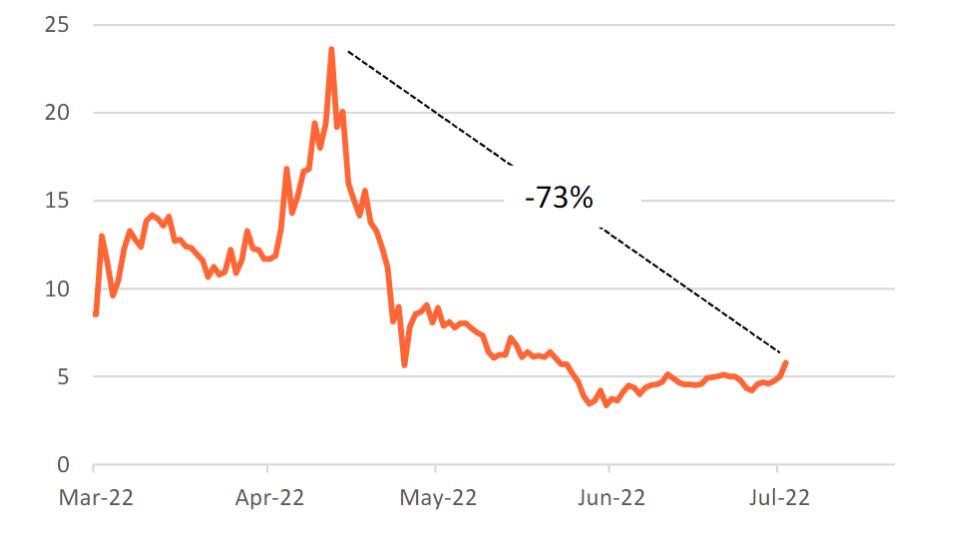
Source: Coingecko, IDEG Research, July 28, 2022
The Future of NFTs
The popularity of NFTs is maintaining its momentum and may become even more widely adopted digital assets in the future as people better understand the technology and integrate them into the virtual world presence (especially with the buzz about the metaverse). In 2021, the market cap was estimated to be at $15.54 billion whereas it is projected to reach $20.44 billion in 2022 (+32% increase).
The NFT market is anticipated to have the potential to grow at a compound annual growth rate of +33.9% until 2030 where it could reach up to 211.72 billion USD in market size, according to Grand View Research.
There are many opportunities NFTs present to creators and artists as they can receive passive income through royalties upon resales of the NFTs which allows them to not only reach a larger market but also cut out intermediaries since the creator can sell directly to buyers and thus realize greater profits.
The opportunity for larger and regular cash flows would encourage more artists into the NFT space which would contribute to driving further growth of the NFT market.
NFTs are also playing a major role in the development of GameFi. An example of its use in the gaming industry is in Axie Infinity, a play-to-earn game that rewards players with cryptocurrency and NFTs which can then be sold in secondary markets for profit. Players can make a livable income from playing the game which presents interesting prospects for those living in developing countries.
Exhibit 3: Axie Infinity
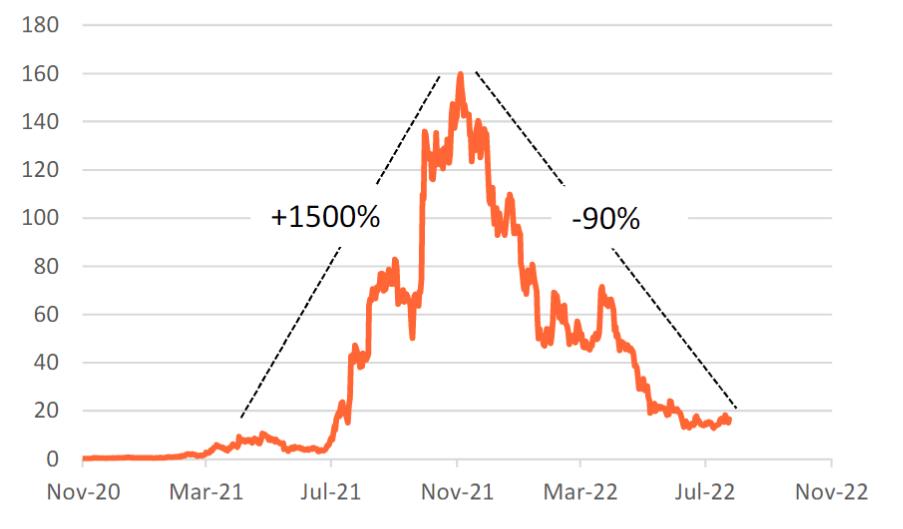
Source: Coingecko, IDEG Research, July 28, 2022
There are also ‘scholarship’ schemes being implemented by gaming companies such as YGG who allow users without starting capital to play for free as well as train and lend them NFTs. Such schemes are encouraging the mass adoption of NFTs and decreasing the barrier to entry which could help fuel demand. Furthermore, gaming NFTs can be even more promising in the future if they are able to realize interoperability across games and even perhaps across chains which would drive up its value through extra utility.
Finally, fractional NFTs are also on rise which allows multiple people to claim ownership to a part of a whole NFT. Although NFTs are designed to be indivisible by nature, smart contracts can be used to convert ERC-721 tokens (representing whole NFTs) into fractions represented by multiple ERC-230 tokens.
This allows increased democratization as smaller investors with limited funds have more investment opportunities, lowering the barrier to entry. Liquidation can also be improved since unique rare NFTs can be bought up through its fractional NFTs quickly for a lower price and can thus be a valuable feature when applied to claiming ownership of more expensive assets such as collectibles and real estate.
Whenever new technology innovations arise, there tends to follow some initial skepticism from the public. So far there has been considerable hype around the digital asset due to celebrity exposure of NFT collectibles, however it is difficult to tell whether this is only a bubble or whether NFTs would grow into something much bigger in the long-term considering the advantages and applications the technology offers.
Current Innovations: Dynamic NFTs
Dynamic NFTs have begun to enter the market and challenge the way people think about NFTs, giving the NFT space an extra surge of excitement.
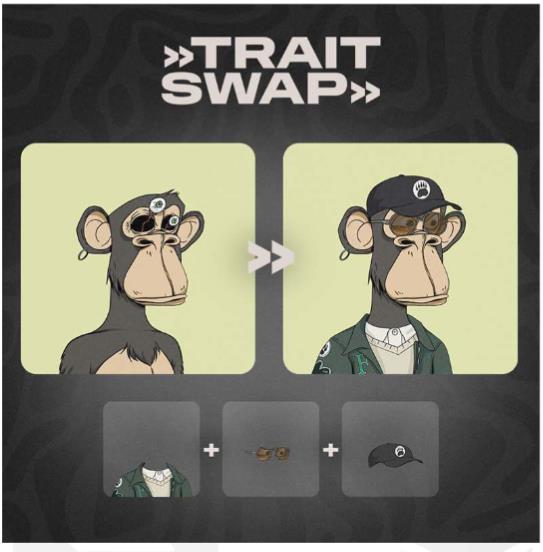
Source: Trait Swap, IDEG Research, July 28, 2022
Unlike conventional static NFTs that are immutable, dynamic NFTs (dNFTs) allow changes and updates to its metadata and can interact with the blockchain and external environment. The magic of dNFTs are credited to the use of smart contracts which automatically respond to both on-chain and off-chain data.
These smart contracts leverage data oracles such as ChainLink to connect the dNFTs to the real world to gain access to Web APIs and IoT data. dNFTs also have the added advantage of interoperability as they can easily be transferred across chains – RareLink’s new token bridge allows the transfer of dNFTs between Etheruem and Polkadot.
Compared to static NFTs which are isolated on a single blockchain and need to constantly be reminted to record metadata changes, dNFTs offer exciting possibilities for new innovative applications.
The NFT collectibles space has become widely populated and saturated with many similar projects, but now Fancy Bears has taken PFP projects to the next level with the launch of their ‘NFT 2.0’ which unites the ERC721 and ERC20 standards, DeFi and Gaming. The now dynamic Fancy bears avatars allow trait swaps where users can collect and trade traits to enhance and upgrade their bears, making them all the more ready for the Web3 metaverse where users can truly own and customize their digital identity.
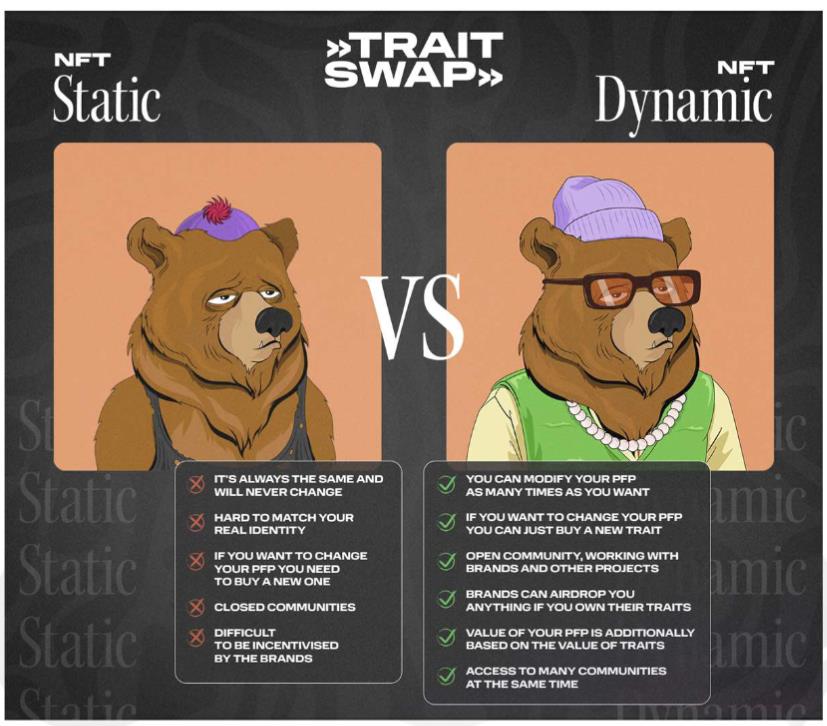
Source: Trait Swap, IDEG Research, July 28, 2022
Fancy bears may continue to grow in value as they extend their roadmap and keep the community engaged with unique developments and brand collaborations such as hunts for sponsored rare traits.
dNFTs have also been making moves in sports cards collectibles. These dNFTs representing athletes now have the opportunities to include variable attributes such as weight, height, number of goals and assists that can automatically update in line with real world events. For example, LaMello (NBA player) released a set of dNFTs that upgrades its image to reflect his game performance and achievements.
In terms of applications more on the utilities side, dNFTs could also be used to reflect changes in official documentation. For example, in real estate, a deed to a property can be represented by a dNFT which contains metadata about factors such as price, sale or renovation history, so all changes recorded are still associated with the same unique NFT.
The realm of digital art has also not been excluded by the influence of dNFTs. One project, OG:Crystals, has released 10,301 crystal reef NFTs that grow a new section of crystal every time the NFT is resold, with its 3D shape being based on information about the holder’s wallet such as transaction time, block number, current wallet ETH balance etc. The ever-changing aspect of dNFT art may add more value to the digital art landscape and further differentiate itself from physical art.
Finally, there have also been experimentation with using dNFTs for fundraising. For example, Regenerative Resources Co have released video NFTs that add a frame upon every subsequent resale (starting initially with only one frame) with all the money raised going towards planting mangroves. This model encourages people to trade the NFT as the final holder will be able to unlock the complete film.